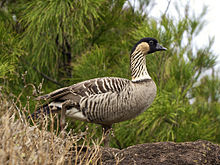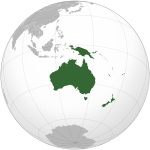Oceanian realm
The Oceanian realm is one of the eight biogeographic realms and is unique in not including any continental land mass. It has the smallest land area of any of the WWF realms.
This realm includes the islands of the
Conversely, New Guinea, New Caledonia, the Solomon Islands and New Zealand are included in the Oceanian realm in the classification scheme developed by Miklos Udvardy in 1975.[2][3]
The Juan Fernández Islands have been included in both the Oceanian and Temperate South American realms.[4] Despite only being a few hundred miles removed from the South American coast, the islands have strong Hawaiian and southeast Polynesian biogeographic influences, and the presence of an endemic insect and plant family.[4] The uninhabited French territory of Clipperton Island, 1,000 kilometers off the coast of Mexico, has also been associated with the realm.[5][4]
Geology
Oceania is geologically the youngest realm. While other realms include old continental land masses or fragments of continents, Oceania is composed mostly of volcanic
.Climate
The climate of Oceania's islands is tropical or subtropical, and range from humid to seasonally dry. Wetter parts of the islands are covered by tropical and subtropical moist broadleaf forests, while the drier parts of the islands, including the leeward sides of the islands and many of the low coral islands, are covered by tropical and subtropical dry broadleaf forests and Tropical and subtropical grasslands, savannas, and shrublands. Hawaii's high volcanoes, Mauna Kea and Mauna Loa, are home to some rare tropical montane grasslands and shrublands.
Flora and fauna
Since the islands of Oceania were never connected by land to a continent, the flora and fauna of the islands originally reached them from across the ocean (though at the height of the last ice age sea levels were much lower than today and many current seamounts were islands, so some now isolated islands were once less isolated). Once they reached the islands, the ancestors of Oceania's present flora and fauna adapted to life on the islands.
Larger islands with diverse ecological niches encouraged floral and faunal
Flora
Land
Botanists generally agree that much of the flora of Oceania is derived from the Malesian Flora of the Malay Peninsula, Indonesia, the Philippines, and New Guinea, with some plants from Australasia and a few from the Americas, particularly in Hawaii. Easter Island has some plants from South America such as the totora reed.
Fauna

Dispersal across the ocean is difficult for most land
Impact of settlement
Many animal and plant species have been introduced by humans in two main waves.
The absence of predator species caused many bird species to lose the instinct to flee from predators and to lay their eggs on the ground, which makes them vulnerable to predators such as cats, dogs, mongooses or rats. The arrival of humans on these island groups often resulted in disruption of the indigenous ecosystems and waves of species extinctions (see
Ecoregions
| Fiji tropical dry forests | Fiji |
| Hawaiian tropical dry forests | Hawaiʻi |
| Marianas tropical dry forests | Guam, Northern Mariana Islands |
| Yap tropical dry forests | Federated States of Micronesia |
| Hawaiian tropical high shrublands | Hawaiʻi |
| Hawaiian tropical low shrublands | Hawaiʻi |
| Northwestern Hawaii scrub | Hawaiʻi, Midway Atoll |
References
- ^ Olson, D. M., Dinerstein, E., Wikramanayake, E. D., Burgess, N. D., Powell, G. V. N., Underwood, E. C., D'Amico, J. A., Itoua, I., Strand, H. E., Morrison, J. C., Loucks, C. J., Allnutt, T. F., Ricketts, T. H., Kura, Y., Lamoreux, J. F., Wettengel, W. W., Hedao, P., Kassem, K. R. (2001). Terrestrial ecoregions of the world: a new map of life on Earth. Bioscience 51(11):933-938.
- ^ Udvardy, M. D. F. (1975). A classification of the biogeographical provinces of the world. IUCN Occasional Paper no. 18. Morges, Switzerland: IUCN.
- ^ Udvardy, Miklos D. F. (1975) World Biogeographical Provinces (Map). The CoEvolution Quarterly, Sausalito, California. link.
- ^ a b c Udvardy, Miklos D.F. "A Classification of the Biogeographical Provinces of the World" (PDF). UNESCO. Retrieved 7 March 2022.
- hdl:10088/19435. Retrieved 2022-01-17.

